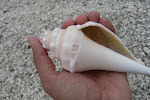 I didn't plan on doing some beach combing the other day and it was a pleasant surprise that the excursion turned up some real good specimens for my shell collection.
I didn't plan on doing some beach combing the other day and it was a pleasant surprise that the excursion turned up some real good specimens for my shell collection.  I was sorting, cleaning, bagging and tagging my specimens when I realized that I have never posted an actual beach combing blog. How funny is that? Anyway, this is what your Beachcomber does when he can in his free time: beachcomb for shells for a biodiversity working collection.
I was sorting, cleaning, bagging and tagging my specimens when I realized that I have never posted an actual beach combing blog. How funny is that? Anyway, this is what your Beachcomber does when he can in his free time: beachcomb for shells for a biodiversity working collection.You can get a permit at CNMI Division of Fish & Wildlife if you want a shell collection. Also remember that the wildlife and natural resources of this world have been entrusted to us for protection and preservation. We all must account to the future for how we handle resources today and if you decide to collect shells it must be done lawfully, conservatively, recognizing that destruction of the marine habitat, by whatever means, is the true enemy of the sea and its creatures. You can read and take the Sheller's Creed.
Abalones (Family Haliotidae) get quite big in colder waters, but in the Marianas they are quite small. Their modest size do not detract from the beauty of these shells though as you can see from the nacre or mother of pearl in the opening where the animal used to live. These are Haliotis clathrata, common name Lovely abalones (Reeve, 1846) and you can find them between 10-60 mm in size.
 Here are two samples that are new to me! Part of the dream of all beachcombers is to discover something new and undescribed and be able to name it yourself! Well, my best friend actually found the one that looks like a sundial (most likely of the Architectonicidae family) so she will have to name it! I will have to check if it is Heliacus caelatus as described by Hinds (1844).
Here are two samples that are new to me! Part of the dream of all beachcombers is to discover something new and undescribed and be able to name it yourself! Well, my best friend actually found the one that looks like a sundial (most likely of the Architectonicidae family) so she will have to name it! I will have to check if it is Heliacus caelatus as described by Hinds (1844). Here are new limpets to my collection that have a nice yellow tint to them. These gastropods or marine snails are usually found attached to rocks with the exposed surface covered in encrustations. When the animal dies the shell gets polished by the water, sand and waves and they show off wonderful architecture and amazing patterns of color. They're in the Patellidae family.
Here are new limpets to my collection that have a nice yellow tint to them. These gastropods or marine snails are usually found attached to rocks with the exposed surface covered in encrustations. When the animal dies the shell gets polished by the water, sand and waves and they show off wonderful architecture and amazing patterns of color. They're in the Patellidae family. Found some cool spines of Eucidaris metularia (Lamarck, 1816), the Ten-lined sea urchin. Although I have never seen them in the water, their spines are a pretty good clue that they are around!
Found some cool spines of Eucidaris metularia (Lamarck, 1816), the Ten-lined sea urchin. Although I have never seen them in the water, their spines are a pretty good clue that they are around!
 I found some Star sand and what I call Halo sand. They are foraminaferans (or forams for short) which are actually marine protists that are big enough to see with the naked eye. The circular Halo sand are Marginopora vertebralis, calcareous and they contribute to the sand makeup when they die.
I found some Star sand and what I call Halo sand. They are foraminaferans (or forams for short) which are actually marine protists that are big enough to see with the naked eye. The circular Halo sand are Marginopora vertebralis, calcareous and they contribute to the sand makeup when they die.
Thank you for letting me share again.
Ti napu.
The Beachcomber
Ti napu.
The Beachcomber


5 comments:
Man bonito na collecion...
BFF
super cool! Thanks for sharing!
BFF & Mai: Thanks! Bonita na famalaoan!
One of the most original blogs out there. Always a pleasure.
Wow! That is very cool! (BTW, I read your posts soon after they are published, I just don't always have the chance to comment.)
Post a Comment